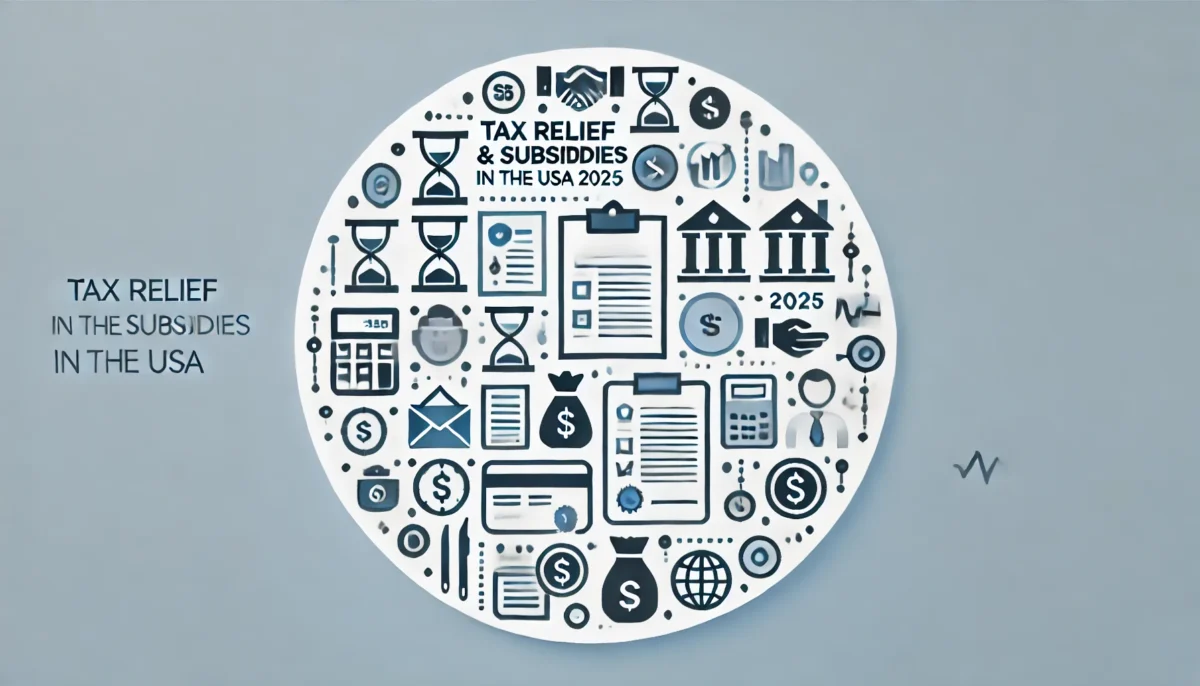How to Qualify for Tax Relief Subsidies in the USA in 2025?
Although taxes can seem excessive, both people and businesses can reduce their financial burden by participating in Tax Relief Subsidies in the USA in 2025. This guide provides all the information you need to qualify for tax relief in 2025, whether you’re looking for credits, deductions, or VAT reductions.
How Does Tax Relief Benefit Citizens?
Tax relief programs help people and businesses save money and invest in the future by reducing the amount of taxes they owe. Among these benefits are:
- Lower payments for income taxes
- Refundable tax credits
- Deductions for healthcare, education and mortgage interest
- Tax benefits for businesses
Significant financial support can be obtained through government tax deductions, especially for small enterprises and people with low incomes.

Tax breaks for individuals and companies
There are several tax relief plans available from the U.S. government for both individuals and corporations.
1. Earned Income Tax Credit (EITC) for low- to moderate-income employees
Provides a tax refund to eligible employees who earn less than a certain amount.
It is estimated that the maximum credit will be $7,000 in 2025.
2. For families with children, the Child Tax Credit (CTC)
Up to $3,600 per child can be given to parents to help with daycare expenses.
Refundable even if no taxes are owed.
3. Tax deduction for homeowners (for property owners)
The deduction for mortgage interest reduces taxable income.
The deduction for property taxes reduces annual tax obligations.
4. Tax Deductions for Small Businesses (for entrepreneurs and business owners)
Deduct costs such as equipment, office rent, and personnel.
Self-employed individuals can claim a deduction on health insurance premiums.
5. Tax exemptions for older person and disabled individuals
Low-income retirees are excluded from paying Social Security taxes.
People with persistent disabilities are eligible for disability tax credits.
Do you need more financial help?
Check out our detailed guide on Top Welfare Programs for Low-Income Families in the USA in 2025.
VAT reduction programs
Sales tax or VAT (value-added tax) reductions contribute to the affordability of necessities. Although there is no federal VAT in the United States, many states offer sales tax exemptions and deductions.
1. Exemption from state sales tax
- Many states have reduced sales taxes on groceries, medications, and educational costs.
- Some states, like Montana and Oregon, have no state sales tax.
2. Tax free shopping days
- Many jurisdictions offer tax-free shopping days for energy-efficient appliances and school supplies.
3. Tax credits for energy efficiency
- Credits are available to homeowners who install solar panels and make energy-saving improvements.
- Federal tax deductions are available to businesses that invest in green technologies.
How do I apply for tax credits?
To receive government subsidies and tax relief, do the following:
1: Ensure Eligibility
- Check the IRS regulations on tax credits and deductions.
- Visit IRS.gov to look up state-specific assistance plans.
2: Collect required documents
- Last year’s tax return
- Evidence of income, expenses, and deductions
- Receipts for business expenses (for entrepreneurs)
3: File a tax return properly
- Use tax preparation software like H&R Block or TurboTax.
- Consider working with a qualified tax expert.
- Make sure you submit all credits and deductions correctly.
4: Subsidy online application
- Use the IRS Free File or tax portal in your state to file tax relief claims.
- Check out the federal tax incentive program at SBA.gov for business-related incentives.
5: Monitor the status of your relief or refund
- To track your progress, use the IRS Where’s My Return tool.
- For upcoming audits, keep a record of your contributions.
FAQ about Tax Relief Subsidies in the USA
Q1. Who is eligible for tax exemptions?
Eligibility for tax exemptions is affected by family size, type of company, job position, and income level. Older people, small enterprises, and low-income people are often eligible for the most benefits.
Q2. If I work for myself, am I eligible for tax relief?
Indeed! Expenses such as internet bills, health insurance premiums, and home office expenses can be forgiven by self-employed people.
Q3. Is it necessary to hire a tax expert to claim tax relief?
Not always. The process is simplified by many online tax filing options. However, hiring an expert can guarantee compliance and optimize deductions.
Q4. How long does it take to benefit from tax relief?
After filing, tax returns usually arrive two to four weeks later. Business tax incentives may take longer, depending on the program’s rules.
Q5. Are there ways to get student loan tax relief?
Indeed! Borrowers can deduct up to $2,500 in loan interest payments per year under the student loan interest deduction.
Remarks
Individuals and companies can save thousands of dollars per year by qualifying for tax exemptions and subsidies. Using these programs is essential to financial security, regardless of whether you qualify for a corporate tax deduction, VAT deduction, or income tax credit.
For additional government benefits and assistance programs, check out Top Welfare Programs for Low-Income Families in the USA in 2025.
Visit your state tax office and IRS.gov’s website to stay informed about tax relief programs. If this advice was helpful to you, tell your friends and family about it so they can save money on taxes!
